The Gallery That Started
It All
by Bob Brooke
From the 1880s until the First World
War, western Europe and the United States witnessed the development
of a new style which became known as Art Nouveau or New Art.. Taking
inspiration from the unruly aspects of the natural world, It
influenced the applied arts, graphic arts, and illustration, as well
as architecture.
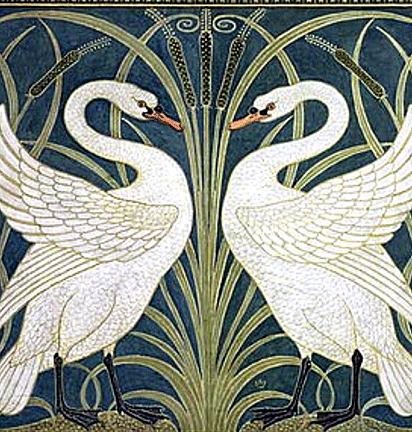
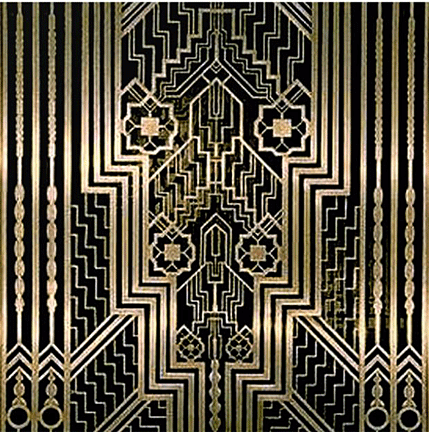 The
distinguishing ornamental characteristic of Art Nouveau was its
undulating asymmetrical line, often taking the form of flower stalks and
buds, vine tendrils, insect wings, and other delicate and sinuous
natural objects. The line could be elegant and graceful or infused with
a powerfully rhythmic and whiplike force. The
distinguishing ornamental characteristic of Art Nouveau was its
undulating asymmetrical line, often taking the form of flower stalks and
buds, vine tendrils, insect wings, and other delicate and sinuous
natural objects. The line could be elegant and graceful or infused with
a powerfully rhythmic and whiplike force.
The innovating artists that created Art Nouveau sought to escape the
eclectic historical styles that had previously been popular by
modernizing them. Artists drew inspiration from both organic and
geometric forms, evolving elegant designs that united flowing, natural
forms.
The main influence for this new style was the Industrial Revolution. The
designers welcomed its technological progress which gave them access to
a variety of new materials and processes with which to create all forms
of art.
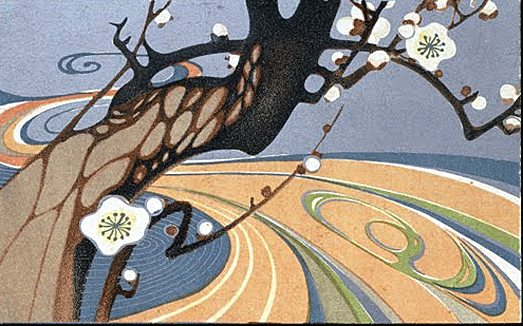
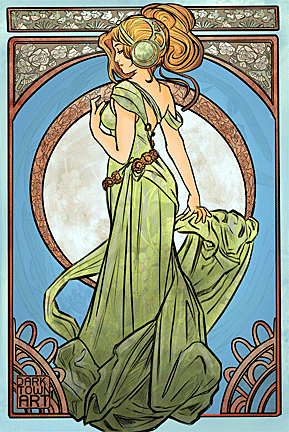 Japonism, a wave of enthusiasm for Japanese woodblock printing, was
another important influence on the new style. The works of Hiroshige,
Hokusai, and Utagawa Kunisada, imported into Europe beginning in the
1870s, became the chief influencers. The enterprising Franco-German art
dealer Siegfried Bing founded a monthly journal, Le Japon Artistique in
1888 and published 36 issues before it ended in 1891. The stylized
features of Japanese prints appeared in Art Nouveau graphics, porcelain,
jewelry, and furniture.
Japonism, a wave of enthusiasm for Japanese woodblock printing, was
another important influence on the new style. The works of Hiroshige,
Hokusai, and Utagawa Kunisada, imported into Europe beginning in the
1870s, became the chief influencers. The enterprising Franco-German art
dealer Siegfried Bing founded a monthly journal, Le Japon Artistique in
1888 and published 36 issues before it ended in 1891. The stylized
features of Japanese prints appeared in Art Nouveau graphics, porcelain,
jewelry, and furniture.
Art Nouveau was a European phenomenon.
From Belgium and France, Art Nouveau spread to the rest of Europe,
taking on different names and characteristics in each country---Jugendstil
in German, Stile Liberty in Italian, Modernisme català in Catalan, and
Modern Style in English. The style was most popular between 1890 and
1910 during the Belle Époque period that ended with the start of World
War I in 1914.
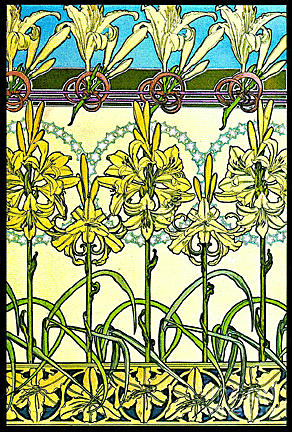 It
often appeared not only in capital cities, but also in rapidly growing
ones that wanted to establish artistic identities, such as Nancy and
Strasbourg in France, Turin and Palermo in Italy; Glasgow in Scotland;
Munich and Darmstadt in Germany, as well as in centers of independence
movements—Helsinki in Finland and Barcelona in Catalonia, Spain. It
often appeared not only in capital cities, but also in rapidly growing
ones that wanted to establish artistic identities, such as Nancy and
Strasbourg in France, Turin and Palermo in Italy; Glasgow in Scotland;
Munich and Darmstadt in Germany, as well as in centers of independence
movements—Helsinki in Finland and Barcelona in Catalonia, Spain.
New technologies in printing and publishing allowed Art Nouveau to
quickly reach a global audience. Art magazines, illustrated with
photographs and color lithographs, popularized the new style. The Studio
in England, Arts et idèes and Art et décoration in France, and Jugend in
Germany allowed the style to spread rapidly. Aubrey Beardsley in
England, and Eugène Grasset, Henri de Toulouse-Lautrec, and Félix
Vallotton in France achieved international recognition as illustrators.
With the posters by Jules Chéret for dancer Loie Fuller in 1893, and by
Alphonse Mucha for actress Sarah Bernhardt in 1895, the poster became
not just advertising, but an art form.
Following the Exposition Universelle in
Paris in 1900, the city became the capital of the new style. The status
of Paris as a center for the arts attracted artists from all over the
world. The Swiss-born artist Eugène Grasset was one of the first
creators of French Art Nouveau posters. He helped decorate the famous
cabaret Le Chat Noir in 1885, made his first posters for the Fêtes de
Paris and a celebrated poster of Sarah Bernhardt in 1890. The Czech
artist Alphonse Mucha arrived in Paris in 1888, and in 1895, made a
poster for actress Sarah Bernhardt in the play Gismonda by Victorien
Sardou in Théâtre de la Renaissance.
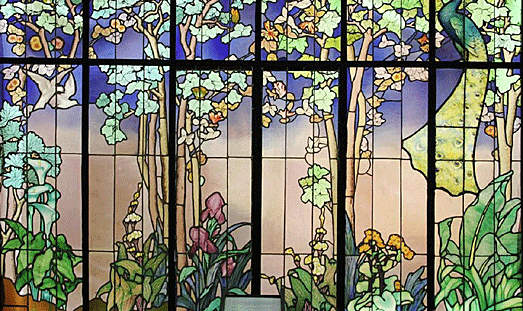
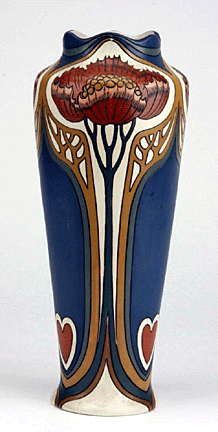 In
1892, he organized an exhibit of seven artists, among them Pierre
Bonnard, Félix Vallotton, Édouard Vuillard, Toulouse-Lautrec and Eugène
Grasset, which included both modern painting and decorative work. This
exhibition was shown at the Société nationale des beaux-arts in 1895. In
the same year, Bing opened a new gallery at 22 rue de Provence in Paris,
the Maison de l'Art Nouveau, devoted to new works in both the fine and
decorative arts. The interior and furniture of the gallery were designed
by the Belgian architect Henry van de Velde, one of the pioneers of Art
Nouveau architecture. The Maison de l'Art Nouveau showed paintings by
Georges Seurat, Paul Signac and Toulouse-Lautrec, glass from Louis
Comfort Tiffany and Émile Gallé, jewellery by René Lalique, and posters
by Aubrey Beardsley. In
1892, he organized an exhibit of seven artists, among them Pierre
Bonnard, Félix Vallotton, Édouard Vuillard, Toulouse-Lautrec and Eugène
Grasset, which included both modern painting and decorative work. This
exhibition was shown at the Société nationale des beaux-arts in 1895. In
the same year, Bing opened a new gallery at 22 rue de Provence in Paris,
the Maison de l'Art Nouveau, devoted to new works in both the fine and
decorative arts. The interior and furniture of the gallery were designed
by the Belgian architect Henry van de Velde, one of the pioneers of Art
Nouveau architecture. The Maison de l'Art Nouveau showed paintings by
Georges Seurat, Paul Signac and Toulouse-Lautrec, glass from Louis
Comfort Tiffany and Émile Gallé, jewellery by René Lalique, and posters
by Aubrey Beardsley.
The Origin of the Term Art Nouveau
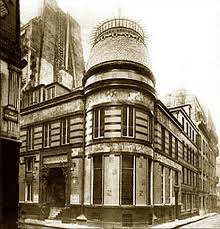 The
Belgian journal L'Art Moderne was the first to use the term Art Nouveau
in the 1880s to describe the work of Les Vingt, a group of 20 painters
and sculptors who sought reform through art. The Maison de l'Art
Nouveau, or "House of the New Art," an art gallery opened in Paris in
1895 by Siegfried Bing, popularized the term. The British commonly used
the French term Art Nouveau while the French called it Style Moderne or
Style 1900. The
Belgian journal L'Art Moderne was the first to use the term Art Nouveau
in the 1880s to describe the work of Les Vingt, a group of 20 painters
and sculptors who sought reform through art. The Maison de l'Art
Nouveau, or "House of the New Art," an art gallery opened in Paris in
1895 by Siegfried Bing, popularized the term. The British commonly used
the French term Art Nouveau while the French called it Style Moderne or
Style 1900.
The Germans referred to the new style as Jugendstil, or "Youth Style," a
term taken from the artistic journal, Die Jugend, or Youth, published in
Munich. George Hirth founded the magazine in 1896. It survived until
1940. During the early 20th century, the German artists applied
Jugendstil only to the graphic arts. It referred especially to the forms
of typography and graphic design found in German magazines such as
Jugend, Pan, and Simplicissimus. Later, they applied Jugendstil to other
versions of Art Nouveau in Germany and the Netherlands.
Characteristics of the Art Nouveau Style
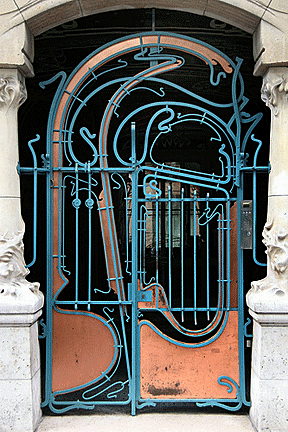 Early
Art Nouveau, particularly in Belgium and France, featured undulating,
curving forms inspired by lilies, vines, flower stems and other natural
forms, used in particular in the interiors of Victor Horta and the
decoration of Louis Majorelle and Émile Gallé. It also drew upon
patterns based on butterflies and dragonflies, borrowed from Japanese
art, which were popular in Europe at the time. Early
Art Nouveau, particularly in Belgium and France, featured undulating,
curving forms inspired by lilies, vines, flower stems and other natural
forms, used in particular in the interiors of Victor Horta and the
decoration of Louis Majorelle and Émile Gallé. It also drew upon
patterns based on butterflies and dragonflies, borrowed from Japanese
art, which were popular in Europe at the time.
The new style often featured more stylized forms expressing movement,
such as the coup de fouet or "whiplash" line, depicted in the cyclamen
plants drawn by designer Hermann Obrist in 1894. A description published
in Pan magazine of Hermann Obrist's wall hanging “Cyclamen,” created in
1894, compared it to the "sudden violent curves generated by the crack
of a whip. Antique experts frequently used the term "whiplash,"
originally used to ridicule the style. Architects used such decorative
undulating and flowing lines in a syncopated rhythm and asymmetrical
shape.
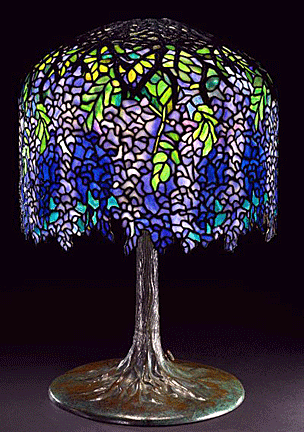 Louis
Comfort Tiffany used other floral forms, inspired by lilies, wisteria
and other flowers, particularly in his lamps, as did the artists of the
Ecole de Nancy and Émile Gallé in their glass objects. They also
embellished the trend, using elegant birds, such as swans and peacocks.
Many designs depicted women's hair intertwined with stems of lilies,
irises and other flowers. Architect and furniture designer Victor Horta
employed stylized floral forms in carpets, balustrades, windows, and
furniture. Hector Guimard these forms extensively for balustrades and
for the lamps and railings at the entrances of the Paris Metro. Louis
Comfort Tiffany used other floral forms, inspired by lilies, wisteria
and other flowers, particularly in his lamps, as did the artists of the
Ecole de Nancy and Émile Gallé in their glass objects. They also
embellished the trend, using elegant birds, such as swans and peacocks.
Many designs depicted women's hair intertwined with stems of lilies,
irises and other flowers. Architect and furniture designer Victor Horta
employed stylized floral forms in carpets, balustrades, windows, and
furniture. Hector Guimard these forms extensively for balustrades and
for the lamps and railings at the entrances of the Paris Metro.
Art Nouveau color schemes leaned toward the muted and somber and became
known as “greenery yallery, using mustard, sage green, olive green, and
brown, often teamed with lilac, violet and purple, and peacock blue.
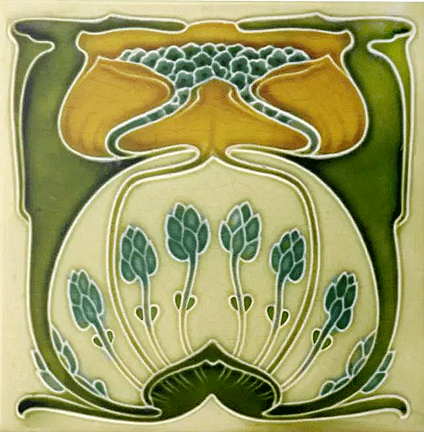 A
wave of decorative art accompanied the debut of Art Nouveau in Brussels.
Important artists included Gustave Strauven, who used wrought iron to
achieve baroque effects on Brussels facades; the furniture designer
Gustave Serrurier-Bovy, known for his highly original chairs and
articulated metal furniture; and the jewelry designer Philippe Wolfers,
who made jewellery in the form of dragonflies, butterflies, swans and
serpents. A
wave of decorative art accompanied the debut of Art Nouveau in Brussels.
Important artists included Gustave Strauven, who used wrought iron to
achieve baroque effects on Brussels facades; the furniture designer
Gustave Serrurier-Bovy, known for his highly original chairs and
articulated metal furniture; and the jewelry designer Philippe Wolfers,
who made jewellery in the form of dragonflies, butterflies, swans and
serpents.
In France, the chief Art Nouveau designers included Louis Majorelle,
Emile Gallé, and Eugène Vallin, all based in Nancy, as well as Tony
Selmersheim, Édouard Colonna and Eugène Gaillard, who worked in Paris.
The latter two worked for Bing's shop.
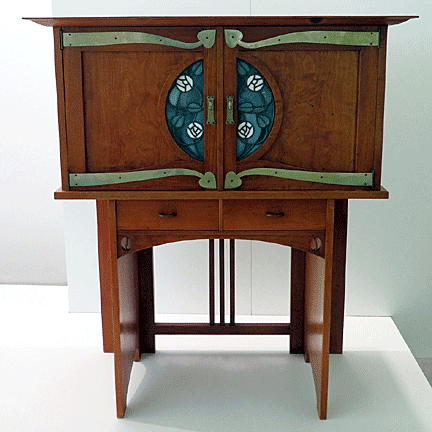 In
France, the style reached its summit in 1900, and thereafter slipped
rapidly out of fashion, virtually disappearing from France by 1905. Art
Nouveau was a luxury style, which required expert and highly-paid
craftsmen, and could not be easily or cheaply mass-produced. One of the
few Art Nouveau products that could be mass-produced was the perfume
bottle, and these are still manufactured in the style today. In
France, the style reached its summit in 1900, and thereafter slipped
rapidly out of fashion, virtually disappearing from France by 1905. Art
Nouveau was a luxury style, which required expert and highly-paid
craftsmen, and could not be easily or cheaply mass-produced. One of the
few Art Nouveau products that could be mass-produced was the perfume
bottle, and these are still manufactured in the style today.
By 1914, and with the beginning of the First World War, Art Nouveau was
largely exhausted. In the 1920s, it was replaced as the dominant
architectural and decorative art style by Art Deco and then Modernism.
<
Back to Caring for Your Collections
Archives
Next Article >
|
